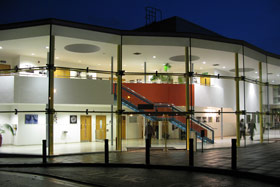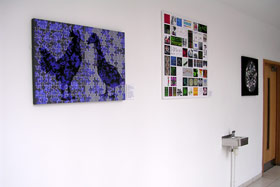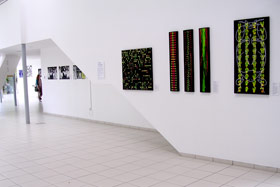

Bio.Pics: life goes on...
Keynes College Atrium, University of Kent, Canterbury
17 September – 30 October 2009



The exhibition marked the final event of a year as artist-in residence at the School of Biosciences.
The residency gave me a wonderful opportunity to revisit life sciences as an artist. I was amazed to see the advances in technical facilities and techniques which have evolved since my early career as a biologist, and which offered exciting imaging possibilities.
In collaboration with scientists, I designed composite images, as visual reflections on a number of the ongoing research projects. Sources include digital photomicroscopy files, captured at high magnification; digital snapshots from confocal microscopes, which scan successive layers through a section of tissue; data; photograms; and drawn elements. Techniques using fluorescent probes are commonly used to target genes and molecules, offering dramatic and colourful input to the composites.
I used pinhole photography to image laboratory and other working spaces. The pinhole cameras, made from laboratory water barrels, require long exposures (up to 16 hours), so capture time rather than freezing it, yielding unique tracings of activity.
‘Annie Halliday's collaboration with the School of Biosciences at the University of Kent has mined a rich seam of scientific activities that take place on a day-to-day basis; extended shots of the laboratory environment, images of live cells obtained using state-of-the-art microscopes; tracking the purification of therapeutic proteins; practical training for over 100 undergraduates. With unique and characteristic style, Annie uses her own scientific background to convey scientific discovery and endeavour - this collection of innovative works cleverly brings the scientific process into focus.’
- Dr. Dan Lloyd Senior Lecturer in Pharmacology,
- Programme Director, MSc Science of Communication and Society,
- School of Biosciences, University of Kent
Continue to composite images gallery...
Continue to pinhole photography gallery...
